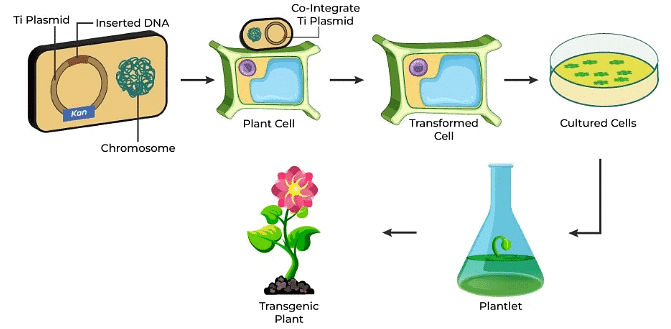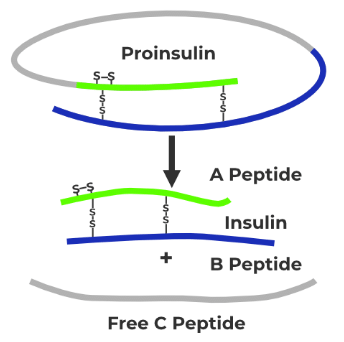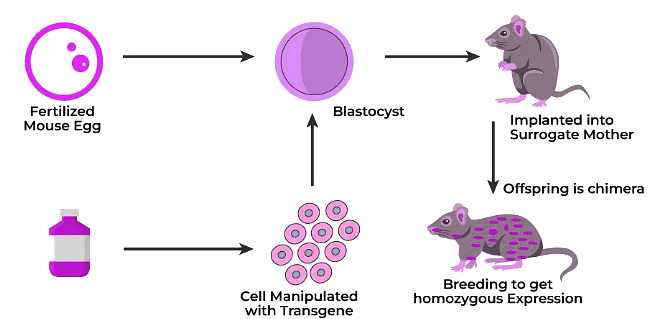Biotechnology and its Applications Chapter Notes | Biology Class 12 - NEET PDF Download
| Table of contents |

|
| Biotechnology Applications |

|
| Biotechnological Applications in Medicine |

|
| Transgenic Animals |

|
| Ethical Issues |

|
Biotechnology Applications
Biotechnology has been employed by scientists for a broad spectrum of modifications and the production of diverse products beneficial to humans. Below are outlined the various applications of biotechnology:
Biotechnological Applications in Agriculture
The concept of "Green Biotechnology" or the "Green Revolution" denotes the utilization of biotechnology in the agricultural domain. Agriculture has witnessed significant advantages from biotechnological interventions, encompassing organic farming, agrochemical-based practices, and the cultivation of genetically engineered crops.

Despite effectively tripling the food supply, the Green Revolution fell short of meeting the escalating demands of the expanding human population. While enhanced crop varieties did contribute to increased yields, the primary successes stemmed from improved management techniques and the utilization of agrochemicals like fertilizers and pesticides. However, many farmers in developing regions struggle to afford these agrochemicals, and conventional breeding approaches prove insufficient for further yield enhancements with existing crop varieties.
In the 1950s, tissue culture technology emerged as a solution to this challenge. Researchers discovered that complete plants could be regenerated from explants, a process known as totipotency. By providing explants with essential nutrients such as sucrose, inorganic salts, vitamins, amino acids, and growth regulators like auxins and cytokinins, a technique called micro-propagation was developed. This method allows for the rapid propagation of numerous plants, each genetically identical to the parent plant. Various staple food crops, including tomatoes, bananas, and apples, have been successfully commercialized through this approach.
Additionally, tissue culture has been instrumental in rescuing healthy plants from infected ones. Even when a plant is afflicted with a virus, the meristem—the plant's growing tip—is typically virus-free. By isolating and culturing the meristem in a lab environment, researchers can generate virus-free plants. Meristems from diverse plant species, such as bananas, sugarcane, and potatoes, have been successfully cultured using this method.
Moreover, researchers have delved into isolating individual plant cells and stripping them of their cell walls to obtain naked protoplasts, encased by plasma membranes. By fusing protoplasts from different plant varieties possessing desirable traits, researchers can create hybrid protoplasts, leading to the development of new plants—a process termed somatic hybridization. Notably, a pomato plant, combining traits from tomatoes and potatoes, was created through this method, although it didn't meet all commercial criteria.
Genetically Modified Organisms (GMOs) refer to organisms whose genes have been manipulated by humans, spanning plants, bacteria, fungi, and animals. GMO plants offer various benefits, including enhanced tolerance to environmental stresses like drought, heat, and salinity, reduced dependence on chemical pesticides via the creation of pest-resistant crops, and improved nutrient utilization efficiency, thus mitigating soil fertility depletion. GM technology has also facilitated the development of custom plants yielding alternative resources such as starches, fuels, and pharmaceuticals.
An illustrative example of biotechnology's impact on agriculture is the creation of pest-resistant plants, potentially reducing reliance on chemical pesticides. This involves cloning the Bt toxin gene from Bacillus thuringiensis bacteria and integrating it into plants, yielding a bio-pesticide conferring insect resistance. Several crops, including cotton, corn, rice, tomatoes, potatoes, and soybeans, have been genetically modified using the Bt toxin gene.
Another breakthrough involves protecting tobacco plants from infestation by the damaging Meloidogyne incognita nematode using RNA interference (RNAi). RNAi, a natural defense mechanism found in eukaryotic organisms, entails silencing specific mRNA molecules through complementary dsRNA molecules, thereby preventing mRNA translation. Researchers introduced nematode-specific genes into tobacco plants via Agrobacterium vectors, leading to the production of sense and anti-sense RNA molecules that triggered RNAi, effectively thwarting nematode infestation in the transgenic plants.
Biotechnological Applications in Medicine
Recombinant DNA technology has made a profound impact on healthcare by enabling the large-scale production of safer and more effective therapeutic drugs. Unlike counterparts sourced from non-human origins, recombinant therapeutics generally provoke fewer unwanted immune reactions. Presently, around 30 recombinant therapeutics have received approval for human use globally, with 12 of these accessible in India.
Genetically Engineered Insulin

The management of adult-onset diabetes necessitates regular insulin administration. However, if an adequate supply of human insulin is unavailable, one option is to extract insulin from other animal sources. Nonetheless, this approach raises concerns regarding its efficacy and potential immune responses in humans. Fortunately, the discovery of bacteria capable of producing human insulin has streamlined the insulin production process. Oral insulin administration to diabetic patients is impractical due to its degradation in the digestive system. Historically, insulin sourced from animals often triggered allergic reactions in certain patients due to foreign proteins. Insulin comprises two polypeptide chains connected via disulfide bridges, with the C peptide, found in pro-hormone, being eliminated during insulin maturation. In 1983, Eli Lilly achieved successful production of human insulin using recombinant DNA technology. This involved integrating DNA sequences corresponding to the A and B chains of human insulin into E. coli plasmids. The separate chains were then isolated and combined to form mature human insulin through the establishment of disulfide bonds.
Gene Therapy

Gene therapy is a method employed to rectify genetic abnormalities present from birth by introducing normal genes into the cells and tissues of affected individuals. The objective is to compensate for malfunctioning genes and assume their functions. In 1990, the first clinical application of gene therapy was administered to a 4-year-old girl with ADA deficiency. This condition results from the absence of the adenosine deaminase gene crucial for the proper functioning of the immune system. While treatments such as enzyme replacement therapy and bone marrow transplantation exist, they do not offer complete cures. In the process of gene therapy for ADA deficiency, lymphocytes are extracted from the patient's blood, cultured, exposed to functional ADA cDNA via a retroviral vector, and then expanded in culture before being reintroduced into the patient. Since these modified lymphocytes are not immortal, the patient requires regular infusions. A more enduring solution could potentially be attained by administering the ADA gene isolated from marrow cells expressing ADA at embryonic stages.
Molecular Diagnosis

- Early diagnosis and understanding the underlying mechanisms of diseases are crucial for effective treatment. However, conventional diagnostic methods often fall short in detecting diseases at their earliest stages. Techniques such as Recombinant DNA technology, Polymerase Chain Reaction (PCR), and Enzyme-Linked Immunosorbent Assay (ELISA) can be utilized for early detection.
- PCR is particularly valuable in identifying low concentrations of pathogens like bacteria and viruses before disease symptoms manifest. This involves amplifying the nucleic acid of the pathogen. PCR is now commonly used to detect gene mutations in suspected cancer or genetic disorder patients and to diagnose HIV in individuals suspected of having AIDS.
- ELISA, on the other hand, identifies infections by detecting the presence of antigens or antibodies synthesized against the pathogen. By using a radioactive molecule (probe) attached to single-stranded DNA or RNA, gene mutations can be detected through probe hybridization with complementary DNA in a cell clone.
Transgenic Animals
Transgenic animals carry an additional foreign gene due to genetic modification. While various animals have been genetically engineered to be transgenic, mice constitute the majority (over 95%) of transgenic animals. Reasons for developing transgenic animals include:

- Studying gene control and its impact on development and daily functions. For instance, genes from different species can be introduced to modify the production of growth-related factors like insulin-like growth factors, shedding light on their biological function.
- Enhancing understanding of how genes influence disease onset and progression. Transgenic animals serve as models for human diseases, facilitating research on new treatments for conditions such as cancer, cystic fibrosis, rheumatoid arthritis, and Alzheimer’s.
- Evaluating vaccine safety through transgenic mice before human trials, potentially replacing the use of primates for vaccine safety assessments.
- Conducting toxicology/safety testing of chemicals, where genes are inserted into transgenic animals to increase sensitivity to toxins, accelerating toxicity testing and data collection.
- Producing biological products for medical use. Transgenic animals can be engineered to produce human proteins like α-1-antitrypsin, used in treating emphysema. They also hold promise in treating conditions such as phenylketonuria (PKU) and cystic fibrosis. Notably, the first transgenic cow, Rosie, produced milk containing human alpha-lactalbumin in 1997, offering a more nutritionally balanced product for human consumption.
Ethical Issues
The manipulation of living organisms by humans necessitates adherence to ethical standards and regulations to assess their impact on organisms and ecosystems. In India, the Government has instituted the Genetic Engineering Appraisal Committee (GEAC) to evaluate genetically modified (GM) research and determine the safety of introducing GM organisms for public use.
Additionally, patents, granted by governments, provide inventors with exclusive rights to commercialize their inventions. This extends to biological resources and their derivatives. Biopiracy refers to the unauthorized utilization of these resources by entities without proper compensation or authorization from the respective countries and communities.
In 1997, an American company acquired patent rights for Basmati rice, claiming it as a new variety, despite it being derived from traditional Indian farmer varieties. Similar attempts have been made to patent products and processes based on traditional Indian herbal medicines like turmeric and neem.
|
88 videos|387 docs|202 tests
|
FAQs on Biotechnology and its Applications Chapter Notes - Biology Class 12 - NEET
| 1. What are some common applications of biotechnology in medicine? |  |
| 2. How are transgenic animals used in biotechnology? |  |
| 3. What are some ethical issues surrounding biotechnological applications in medicine? |  |
| 4. How do biotechnological applications contribute to advancements in personalized medicine? |  |
| 5. What are some key considerations for researchers working in the field of biotechnological applications in medicine? |  |















